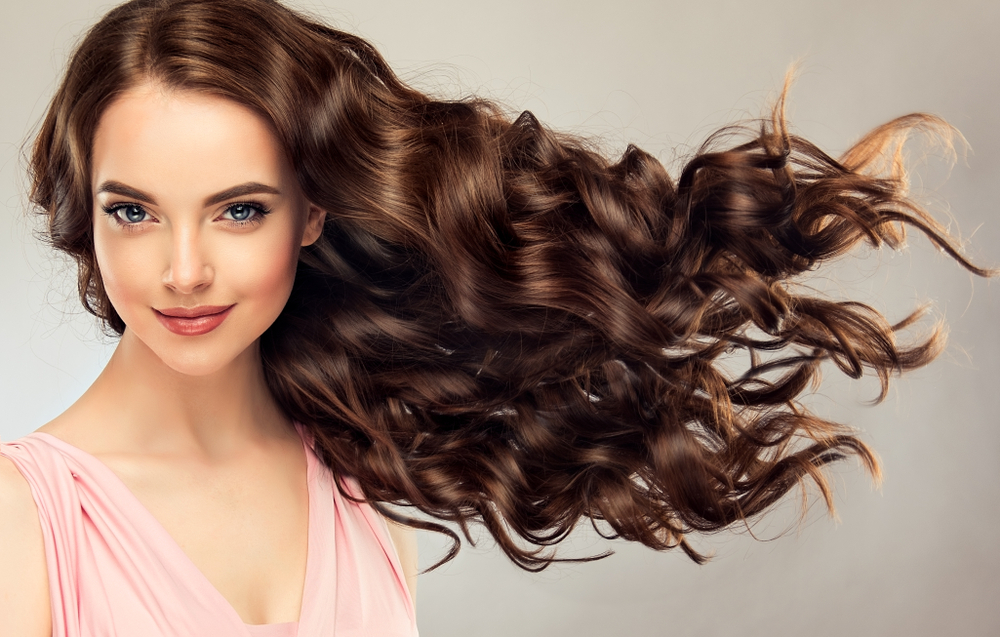More volume? A lot of shine? No problem! We do a lot for healthy hair. Here comes the fitness program for beautiful, well-groomed and healthy hair.
Healthy hair: Lifting for the roots thanks to sebum production
Hair has its natural conditioner: several tiny sebaceous glands are gathered around each hair root. They normally produce as much fat as the hair needs to stay smooth and shiny. However, sometimes it is not enough to rely on nature – hair is dull, lacks volume and needs support to look healthy and shiny again.
In winter the hair is weakened
In winter, the ratio seems to be particularly out of balance, the roots seem greasy, the hair itself rather dry… The reason: Under the cap you start to sweat, the scalp produces more sebum, the hair becomes limp. Everything that brings healthy hair back to life is welcome.
Shampoos (and light conditioners) with herbal extracts, for example with rosemary, lavender, menthol or fruit extracts, clear your head (thanks to their scent). They gradually regulate the fat balance without the scalp being drained and ensure healthy hair.
Our tips:
- Plant extracts astringent, i.e. they gently tighten the scalp, just like a vinegar rinse (a small cup of apple vinegar to half a liter of water).
- For oily scalps and dry tips: Only knead the conditioner into the tips and do not apply to the scalp.
Healthy hair: Styling that also cares
Anything that dries out the hair (for example, too much alcohol in the styling product) makes it brittle. It’s a good thing that more and more manufacturers are adapting to damaged hair. They offer styling products that cleverly combine care ingredients, shine and setting agents. In addition to fast-acting hair straighteners such as silicone oils, styling sprays and creams contain many natural ingredients: avocado oil, grain and light-protecting rice bran extracts, fruit waxes…
And now the manufacturers have also discovered silk ingredients (in spray and cream form) for styling. The extracts envelop the hair, create the cuticle layer, make it easier to comb and protect it.
A special case of sensitive scalp
It itches, and later it trickles; especially in spring the scalp can cause problems because of the change of climate. But stress, frequent washing and daily blow-drying also irritate the skin and dry it out – it flakes. A dandruff shampoo, which is supposed to stop the hornification and regulate the skin functions, does not always help. First of all, anyone with sensitive scalps should use shampoos sparingly.
A trick: shampoo foam instead of gel – automatically saves on the amount because it foams splendidly at the push of a button. Mild shampoos with skin soothing agents are also ideal: for example aloe vera or anti-inflammatory liquorice root extract, oat extract or chamomile oil.
Important: Do not apply styling products or conditioners directly to the scalp, if possible. Unless it is special hair and scalp care with balancing panthenol.
By the way dry, irritated skin is susceptible to germs and bacteria. If the dandruff has not disappeared after about two to four weeks, it is best to make an appointment with a dermatologist.
Hair loss: No reason to panic
Even experts cannot explain it to themselves, but in seasonal change phases many women lose more hair than usual in a year. About 85 percent of the over one hundred thousand hairs are in the growth phase. Between three and six years they are so firmly anchored in the scalp. Only then do they gradually fall out; on average up to 100 per day.
The older the person gets, the shorter the growth phase. But it can be extended: with a scalp treatment after every hair wash with 1.5 percent Aminexil, which is massaged into the scalp.
The blood flow to the scalp and the metabolism of the hair roots increase. This in turn extends the growth phase, “explains dermatologist and hair specialist Dr. Kirsten Wiese from Hamburg.” This active ingredient also keeps the collagen fibers in the scalp elastic. Otherwise the roots of the hair would scar and never again could a hair grow back.
Hair growth: What you can do
Especially with circular hair loss, the connection between zinc deficiency and hair loss has been confirmed several times. In the case of a pronounced deficiency, it can happen that other treatment methods for hair loss do not work. Zinc not only promotes healthy hair growth, it also ensures that the hair is firmly anchored in the scalp. Vitamin B (for example, contained in lamb’s lettuce, chicken, sesame seeds) and iron (in nuts, spinach, rocket, peas) are also important for healthy hair.
Styling tips for more volume
Even with hair that is over shoulder length, the perfect volume cut is stepped – and can be cut by the hairdresser so that the hair falls nicely into one another. If all hairs are the same length, gravity simply pulls them straight down. We’ll show you the best ideas for a step cut.
- One (optical) trick is light highlights: The contrast makes the hairstyle immediately more vivid. And because blonde hair always roughens the hair structure a little, the hair does not become greasy so quickly. But this volume trick is only for healthy hair!
- The best blow-drying technique: Hold strand by strand upwards over a thick round brush and blow-dry against the direction of growth; complete each blow-drying session with cold air. And for dry scalps that cannot tolerate the blow-drying air? After washing, knead in a styling foam and turn the almost dry hair onto thick volume rollers, allow to dry and brush over only briefly.
- The express tip: Throw hair upside down, spray the roots with hairspray, shake into shape, done!

